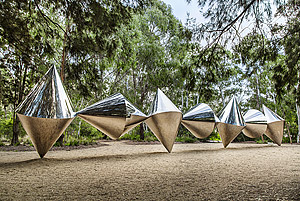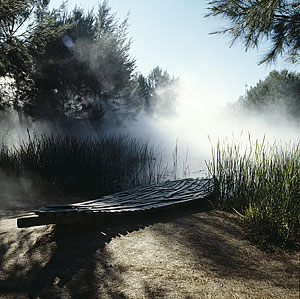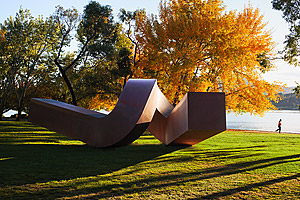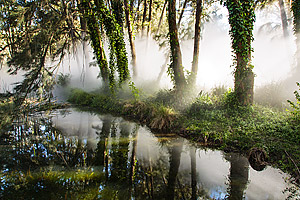Collections
Sculpture garden | Art in Landscape
Introduction | History | Fern Garden | Highlights
'Sculpture should be displayed in conditions specially appropriate for it which may be indoors or, perhaps more frequently, in a garden or park setting or in an inner courtyard open to the sky.'1
In August 1975, at its first meeting, the Building Committee of the National Gallery's Interim Council agreed to seek the view of the National Capital Development Commission (NCDC)2 on the boundaries of the area of land to be controlled by the Gallery with particular reference to the placing of sculpture. With a Sculpture Garden in mind, works had already been acquired by Auguste Rodin, Henry Moore, Alexander Calder and Clement Meadmore, and over the next few years the Gallery would purchase sculptures by Aristide Maillol, Emile Antoine Bourdelle, Gaston Lachaise, Mark di Suvero, Bert Flugelman, Inge King, Fujiko Nakaya, Robert Stankiewicz and Tony Coleing, along with a group of Pukamani poles from Bathurst Island and several slit-drums from Vanuatu. By 1977 a specific policy had evolved for a Sculpture Garden which would contain some fifty sites to accommodate work from human scale to monumental, to illustrate the development of sculpture during the modern period in Australia and overseas.
 Bert Flugelman Cones 1976/82 polished stainless steel Collection of the National Gallery of Australia © Bert Flugelman more detail
Bert Flugelman Cones 1976/82 polished stainless steel Collection of the National Gallery of Australia © Bert Flugelman more detail A plan is developed
The NCDC's agent architects for the Gallery building, Edwards, Madigan, Torzitlo and Briggs, were briefed on the parameters for the design of the Sculpture Garden in April 1978; and landscape architects Harry Howard and Associates were subsequently appointed to the project. Howard had graduated in architecture from Sydney University in 1954 and was an associate of Edwards, Madigan and Torzillo between 1959 and 1965 before moving to landscape architecture. He was familiar with principal architect, Colin Madigan's design philosophy and was to prove ideally qualified to assimilate landscape elements within an architectural framework specified by Madigan.
In mid 1978 Colin Madigan and the Director, James Mollison, travelled overseas together to study sculpture gardens. They returned with the conviction that the one they would create in Canberra would be of international significance. Architectural and landscape concepts were developed and refined, leading to a meeting held in October 1978 to assess the Gallery's requirements for the Sculpture Garden attended by James Mollison and Tony George from the National Gallery, representatives of the NCDC, Colin Madigan and Roger Vidler of Edwards, Madigan, Torzillo and Briggs, and Harry Howard and Barbara Buchanan of Harry Howard and Associates.
 Harry Howard and Associates Final sketch plans
for the Sculpture Garden 1979 more detail
Harry Howard and Associates Final sketch plans
for the Sculpture Garden 1979 more detail Colin Madigan presented 'A Policy for Landscape and Sculpture. Australian National Gallery', which placed a premium on the coordinated display of sculpture within the Garden to extend the visitor experience from inside the Gallery. He proposed several major architectural elements to define boundaries and circulation: an earth berm delineated the southern boundary; an amphitheatre for staging public programs was sited at the opposite end of the Garden; a paved court for sculptures of human scale was located alongside the northwestern corner of the Gallery. The strongest single architectural statement was a major avenue connecting the paved sculpture court and the Gallery building to Lake Burley Griffin.
The plan for the Garden reinforced the Gallery's relationship to the overall design concept of Canberra’s Parliamentary Triangle; and at the local level it was disciplined by the same equilateral triangular grid which was the underlying form of the Gallery’s architecture.3 The Garden and the Gallery building would be further linked through common hard surfaces, such as Mintaro slate tiles, bush-hammered off-form concrete walls and exposed aggregate paving.
In his 'Sculpture Gardens. Australian National Gallery, Canberra, Study 1', Harry Howard outlined his concept for the landscaping – that it would provide physical and psychological comfort allowing visitors to orient themselves and be guided through a sequence of varying 'gallery' spaces or rooms. The planting was to comprise only Australian native species and, in particular, those occurring around the Canberra region. The asymmetrical and haphazard character of Australian trees and plants would in time soften the formal architectural principles underpinning the design.
James Mollison outlined the Gallery's prerequisites. Sculptures and the lake were not to be seen at the same time, and not in strong light. Visitors were to be aware that the Garden was man made and occupied by man-made objects rather than a profusion of nature. The Garden was to be considered as a 'podium' and no detraction was to occur from natural elements, which were to provide a variety of settings for sculpture, each created with the same care as a room. It was envisaged that the Sculpture Garden would become the symbol for the Gallery rather than the building itself.
The principles expressed at that seminal meeting informed the continuing design development of the Sculpture Garden. During the following six months a number of formal discussions were held between the design team and the Gallery. At Mollison's request the area was refined by pulling the northern boundary back from the lake's edge and an existing cycle path was relocated to the edge of the lake. It was agreed that tree planting should be introduced alongside the 23-metre high Gallery walls facing the sculpture court.
In December 1978 Harry Howard was able to present sketches locating the sculptures in the Garden and showing the paths related to their positions. The platforms in the earth berm enclosure were developed as outdoor rooms, with their disposition related to the Golden Mean.
The chance find of a water spiral by a water-divining member of the architectural team led to the eventual set out for the Marsh Pond.
In July 1979 the approved final sketch plans were presented to the Gallery, with the evolution of the design to continue throughout the documentation period. James Mollison retained an active interest in the development of the final design, even seeking information from the Herbarium at the Australian National Botanic Gardens to complement the recommendations of Harry Howard and his assistant Barbara Buchanan.
During the documentation period the Garden came to be divided into four areas, each representing a season of the year. The plantings were defined according to flowering times, the colour of foliage and flowers, fragrance, height at maturity and habit. The planned Autumn Garden was not included in the original scope of work. It was to be completed when the initial Winter, Spring and Summer gardens were filled.
At the beginning of 1981 an estimate of costs for the construction of the Garden identified a budget over expenditure, and major architectural elements were deleted from the scope of the work a pergola intended for a site above the Marsh Pond, a kiosk, and the amphitheatre (although the earthworks for the amphitheatre were completed and the area sown to grass). Savings of lesser magnitudes were implemented throughout the entire project. While subsequent tenders for the construction work proved less expensive than anticipated, the deletions were not re-instated by the NCDC.
After construction of the building, the Garden is established
 (background) Mark di Suvero Ik ook 1971–72 painted steel more detail (foreground) Emile Antoine BourdellePenelope 1912 (cast 1972) bronze both Collection of the National Gallery of Australia more detail
(background) Mark di Suvero Ik ook 1971–72 painted steel more detail (foreground) Emile Antoine BourdellePenelope 1912 (cast 1972) bronze both Collection of the National Gallery of Australia more detail With the completion of the Gallery building in 1981 landscaping work commenced on a three-hectare site formerly occupied by construction roads, materials stockpiles, a concrete plant, sub-contractors' yards and various offices. The ground contained mudstone, overlaying clay shale containing rock and concrete fine alluvium and an old creek bed.
The initial plantings comprised species for short and long-term growth. Faster growing acacias were used as cover for slower growing eucalypts and fragile shrubs and ground covers. The planting was informal, with dense groupings of eucalypts interspersed with a large variety of acacias, melaleucas, banksias, grevilleas, hakeas and many other kinds of native plants, grasses and groundcovers. The seasonal nature of the garden is characterised by groupings of plants flowering during the same time of year. Intense sun, harsh frosts and strong prevailing winds led to some plant failure, requiring supplementary planting in 1983.
Some acacias were intended to self-seed or be replaced with the same species when they were past maturity. As the Garden matured and the ground space became more open, the understorey was planted with more shade tolerant species to achieve a multilayered effect. The Autumn Garden was roughly sketched out along the berm wall, but remains unfinished.
Harry Howard and Associates produced a maintenance manual for use in conjunction with the original planting schedules to preserve the character of the design; and Canberra's City Parks Administration of the Department of the Capital Territory maintained the Garden through direct liaison with the Director at no cost to the Gallery. After self-government for the Australian Capital Territory was introduced in 1989 the existing arrangement continued until the ACT government could no longer carry the financial responsibility for maintaining all Commonwealth lands within the Territory. From July 1992 the National Capital Planning Authority (born out of the NCDC) assumed responsibility for the management, care and maintenance of significant tracts of national land, including the Sculpture Garden. The Gallery maintains ownership of the land and jurisdiction over works from the collection.
Installation of most sculptures occurred between July and October 1982.
Further works were acquired: Robert Stackhouse's On the beach again was installed in 1984, and two additional figures by Rodin, Eustache de Saint Pierre and Andrieu d'Andres were acquired in 1985 and joined The burghers of Calais already in the sculpture court, Pierre de Wiessant and Jean d'Aire
 The marsh pond in the Sculpture Garden (background) Fujiko Nakaya Fog sculpture 1976 water vapour (foreground) Robert Stackhouse On the beach again 1984 bronze both Collection of the
National Gallery of Australia more detail
The marsh pond in the Sculpture Garden (background) Fujiko Nakaya Fog sculpture 1976 water vapour (foreground) Robert Stackhouse On the beach again 1984 bronze both Collection of the
National Gallery of Australia more detail In 1986 Robert Klippel was commissioned to construct a full-scale model in wood of the maquette for Opus 302 which he had produced for the Gallery. The sculpture, some 40 metres long, was intended to be cast in bronze and sited on the level above the Marsh Pond in the Autumn Garden, but the work was not endorsed by the Gallery’s Council and the model was removed in 1988. Two decorative panels by Clement Meadmore, made in 1961, were saved from Canberra's Town House Motor Inn and installed on a wall facing the Winter Garden in 1989. Tony Coleing's To do with blue, purchased in 1 975, was restored by the artist and installed in the Autumn Garden area in 1996. Robert Klippel's Number 751 1989 (cast 1997) was installed above the site for the amphitheatre in 1997 in memory of Michael Lloyd, the Gallery's Assistant Director (Collections).
Over the past decade acquisitions for the Sculpture Garden have been largely circumvented because of the competing priorities of the collection policy.
The Sculpture Garden
The formal entry to the Sculpture Garden is through the Winter Garden at the northwestern side of the Gallery building where the intimate paved courtyard, protected from westerly winds and capturing winter sunlight, contains a collection of figurative works from the late nineteenth and early twentieth centuries. The scale of the sculptures, the low blade walls, the plantings and the protected aspect serve to humanise the height of the building and make a welcome introduction to the Garden.
Aristide Maillol's The mountain 1937 (cast 1973) is seen against a mass planting of Acacia iteaphilla, banksias and correas, its matt lead surface projecting harmoniously from the slightly grey-green foliage backdrop. A plinth raises the figure to a height that accentuates the triangular composition – before the plantings had matured the triangle of Mt Ainslie could be glimpsed in the distance.
The group of four bronze figures from Auguste Rodin's The burghers of Calais along with two nude studies c.1885–86 (cast 1967–85), stand in the centre of the courtyard bounded by slate paving and the eucalypts flanking the bush-hammered concrete walls of the building.
At the side of this tableau, positioned in a long formal pool, which locates the adjoining glass-walled Water Gallery, Floating figure 1927 (cast 1979) by Gaston Lachaise levitates above the water. The Emile-Antoine Bourdelle bronze, Penelope 1912 (cast 1972), gazing down the central slate avenue to the lake, completes this assembly of cast figurative bronzes.
The works in the sculpture court are mounted on bases of honed Melbourne basalt, more commonly known as bluestone, the volcanic honeycombed surlace creating a subtle, yet distinct interlace between the sculptures, the slate paving and plantings. At various times, studies or maquettes for these sculptures are displayed along the ramp inside the building and overlooking the courtyard.
 Clement Meadmore Virginia 1970–73 cor-ten steel, mild steel, rust patina Collection of the National
Gallery of Australia © Clement Meadmore, 1970–73/VAGA.
Licensed by VISCOPY, Sydney 2003 more detail
Clement Meadmore Virginia 1970–73 cor-ten steel, mild steel, rust patina Collection of the National
Gallery of Australia © Clement Meadmore, 1970–73/VAGA.
Licensed by VISCOPY, Sydney 2003 more detail A grassed lawn dotted with Eucalyptus manniferra leads down to the Lake and provides an open setting for massive sculptures by Mark di Suvero, lkook 1971–72, and Clement Meadmore, Virginia 1970–73. The original planning intended a sculpture in the lake at the end of the processional avenue.
The Spring Garden runs parallel to Lake Burley Griffin and contains distinct 'rooms' formed by massed plantings of predominantly eucalypts, banksias and grevilleas connected by gravel or exposed aggregate paths. Alexander Calder's La Bobine 1970 was originally sited within this section (in two successive locations) before relocation to the pavement at the ground-level entrance to the Gallery. Richard Stankiewicz's Australia no. 15 1969 was installed in 1996 on a grassy knoll formally occupied by the Calder. Temple gate 1976–77 by Inge King and a group of Pukamani burial poles 1979–84 from Bathurst and Melville Islands are also to be discovered within distinct rooms in the Spring Garden.
The Summer Garden is marked by a grove of Casuarina cunninghamiana and the Marsh Pond planted to lilies and rushes. The casuarinas provide welcome shade in summer and a distinct aural ambience when wind passes through their needled foliage.
As in the sculpture court, the sculptures in the Summer Garden interact with the environment in manifold ways. Two large works, Hill arches 1973 by Henry Moore, and Cones 1976/82 by Bert Flugelman are at either end of this garden. The highly polished and mirrored Cones, at first glimpsed through the adjacent plantings, provide a sharp contrast against an expanse of white gravel surrounding the sculpture. The Henry Moore sits in languid repose by the edge of the Marsh Pond, the lustrous bronze surface intentionally played off against the surface of the pond.
Close by, Robert Klippel's Group of eight bronzes 1981 are positioned in the water backed by rushes and a wall of casuarinas. Here the water is used to protect the fragile nature of the sculptures which were originally located along the avenue leading to the lake’s shore. Vanuatu slit-drums c.1970 appear as wooden sentinels, their surfaces weathered and grey and distinct amongst the black trunks of the casuarinas.
On the beach again 1984 by Robert Stackhouse is a site specific work created to take full advantage of its position at the edge of the Marsh Pond. Half in the water, half out, the form is framed in a confluence of shaded shoreline and reflective water. Fujiko Nakaya's Fog sculpture, originally installed in Sydney's Domain as part of the 1976 Biennale, generates a fine mist over the Marsh Pond and surrounding plantings (as water at high pressure is forced through 75 micron diameter holes in nozzles mounted on a series of frames concealed in the landscape).
Such an extensive area for the display of significant sculptures from Australia and overseas, and planted exclusively to Australian native species is the unique product of the finest aspirations, forged with professionalism and the quest for excellence. In the relationships cultivated between art, architecture and the natural environment, the Sculpture Garden is a rare achievement. In 1994 the Australian Heritage Commission listed the National Gallery's Sculpture Garden in its Register of the National Estate.
Harijs Piekains
essay published in the National Gallery's of Australia's Building the Collection publication 2003
Notes
1 'Report of the
National Art Gallery Committee of Inquiry' (Lindsay Report), 1966, p.27
National Gallery of Australia (NGA) Research Library.
2 The planning,
development and construction of the city of Canberra, the Nation's Capital,
was the responsibility of the National Capital Development Commissioon,
thus construction of the National Gallery was also the NCDC's responsibility.
3 For Colin Madigan's
design for the Gallery building see Robert Bell's essay, 'Crystal Clear',
in the National Gallery's 2003 publication Building the Collection,
pp.338–343


